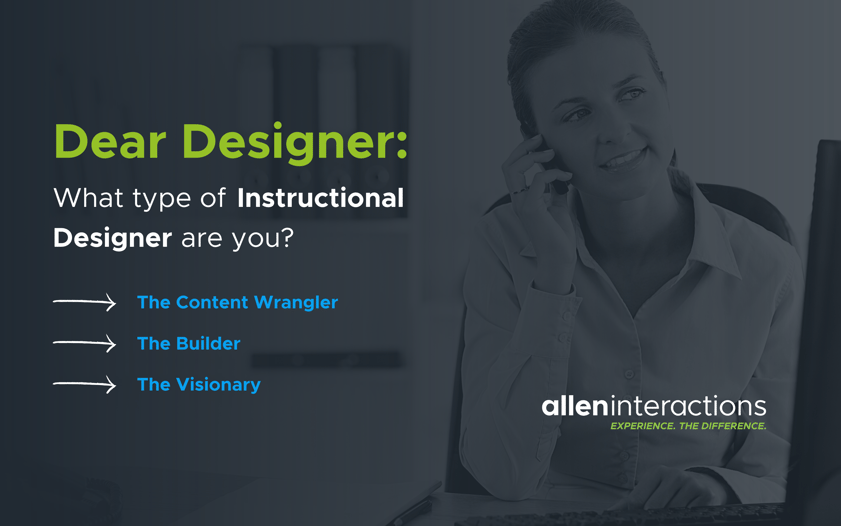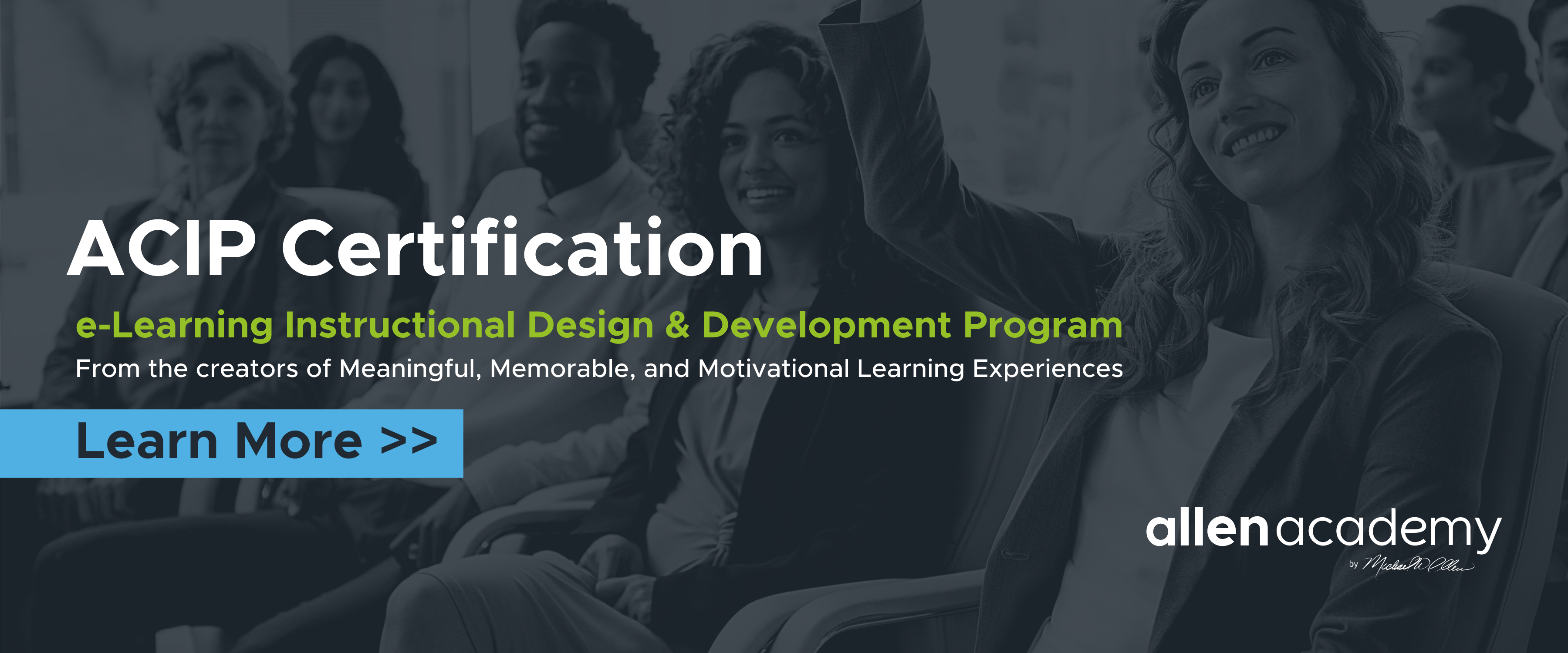Blog
Three Solid Instructional Design Principles in The Big Short
“Dear Designer” is a blog series on orienting novice practitioners to the discipline of instructional design and learning experience design.


Dear Designer: What Type of ID Are You?
By Ellen Burns-Johnson | February 20, 2020 | Custom Learning | 0 Comments
“Dear Designer” is a blog series on orienting novice practitioners to the discipline of instructional design and learning experience design.
I’ve been lurking on the instructional design subreddit for the last few months. It seems like a growing community with some great resources—they have a Discord channel and a weekly “No Stupid Questions” thread. I’ve noticed that one of the most popular questions, posted over and over again to the community, is “How do I get my first job?”
People come to be instructional designers (IDs) in a variety of ways. Some transition into the practice from primary or secondary education, some from marketing or business analytics, some from a background in multimedia production or digital design. One of my colleagues has a master’s degree in theater, another a background in poetry, and a third is an experienced meditation instructor. The paths into the role are many and delightfully diverse.
But as a new practitioner or an aspiring one, the wandering paths to the profession can make it difficult to feel confident that you’re headed in the right direction. Sure, there are many great posts about what skills IDs need these days, but these can feel overwhelming in their breadth and detail. Instructional design is a complicated practice that exists at the convergence of many disciplines. This makes it fun to do the work once you start it, but it also makes it hard to figure out where to start!
As far as getting your first ID job, the advice on the r/instructionaldesign subreddit varies. Some say you should get a professional certificate; others say don’t bother. Some say you should get a graduate degree; others say skip it. One seemingly universal suggestion is to build a “good portfolio,” but “good” can depend on what kind of role you want.
As if things weren’t complicated enough, there are different “flavors” of ID. This was one of the most confusing aspects of the field when I first started, and things have only become more tangled since. So, I thought it might be helpful to provide a super-quick orientation to three “flavors” of ID. Each of the descriptions below might align with positions you’d see posted as “instructional designer,” but as you’ll see, different skills are needed. I also included some ideas for what you’ll want to put in your portfolio if that’s the type of work you want to do.
1: The Content Wrangler

This “flavor” of ID is highly content-focused. As a Content Wrangler, it’ll be your job to get content out into the world so that learners can access it. Sometimes your work will come to you in the form of a heavy manual dropped on your desk by a stakeholder. “Make a course from this,” they’ll say. You may work with subject matter experts (SMEs) to get the information that “lives in their heads” into a format that others can learn from, like a video, instructor-led training course, or e-learning. Perhaps you’ll be working from a template that a more senior designer created, and your role will be to produce modules from that existing design. Either way, the focus of the Content Wrangler ID is to organize instructional information and get it out in the world.
I imagine some readers will argue that the above description isn’t considered “instructional design” at all because it mentions nothing about behavior change and improving learner performance. I absolutely agree that training is about getting people to do the right thing at the right time, but education typically has more content-oriented goals, and some instructional design positions reflect this. Whether education should be structured and assessed more like training is a worthy topic for discussion, but it’s not the point of this post—so I’ll leave that conversation for Twitter and the comments section. 😊
At Allen Interactions, we do have a role that’s similar to the Content Wrangler—the Instructional Writer (IW). IWs might be experienced copyeditors who contract with us for longer projects, but they might also be junior employees who are interested in eventually becoming fully-fledged instructional designers. While in the IW role, these junior staff work with clients on all types of projects, but the heavy analysis, design, development, and project management work is handled by the more experienced people on the team.
Interested in becoming a Content Wrangler? Here’s what you might include in your portfolio:
- Examples of writing for different audiences (business, academic, technical)
- Writing for different media (print, video, apps, web, etc.)
- Writing for different devices (desktop, mobile)
- Evidence of your ability to collaborate with others from a variety of backgrounds—you'll need to work with SMEs, project managers, project sponsors, designers, etc.
- Lesson design and/or curriculum design that demonstrates your ability to turn content into instructional material that aligns with organizational goals
2: The Builder

In the role of Builder, you’ll be an e-learning development expert. You’ll focus on the authoring tools: Storyline, Captivate, Lectora, or something else. You’ll know the ins and outs of one or more Learning Management Systems (LMS). Depending on your role, you might even learn web development or how to use game development engines like Unity, Unreal or Construct. In your role, you’ll collaborate with stakeholders and others to build something from scratch or to modify the features and functionality of existing models. You might do some design work on your own, and some content writing, but your strengths lie in creating instructional applications that do the things you need them to do—without going over budget!
At Allen, our Builders are even more specialized than this. We have UX design experts, full-stack web developers, and multimedia artists. These specialists collaborate with our instructional designers to produce the type of learning experiences our clients are looking for. In my experience, most IDs work in more generalized teams, where each person serves multiple roles in the design, development, and media spaces. That may be starting to change as learning solutions incorporate a wider variety of digital experiences (AR, VR, etc.)
If this is where you want to take your career, work to include these artifacts in your portfolio:
- Multiple finished examples of instructional interactivity that you created with your tool(s) of choice
- Evidence of your ability to collaborate with others, especially incorporating feedback into a work-in-progress
- Examples of how you use project management principles to keep things on track
3: The Visionary

The Visionary “flavor” of instructional designer guides the work of others. A Visionary is more of a consultant and analyst than a Builder or Content Wrangler—you’ll work to understand the organizational needs behind a training or education initiative, and as a solution takes shape, you’ll continually check to make sure it solves the right problems. You’ll capture what learners need to do after they complete a course and how their learning journey will unfold over longer periods of time. You’ll make sure that training and education is learner-centric, based on your empathy for the learner and a deep understanding of their needs. Your main role in collaborating with others will be to ask the right questions, to make sure the right information comes to light so that the right solution can be built. And while you might do some writing and development, your main role is more akin to an executive producer on a movie set; you’ll collaborate with writers, artists, and developers to guide the learning product as it comes into being.
Here’s what you could include in your portfolio for a Visionary role:
- Large-scale curriculum planning
- Reports with analysis and recommendations
- Evidence you can elicit and facilitate lively, respectful discussions and brainstorming sessions (soft skills!)
- Products from design thinking exercises
- User personas
Final thoughts
These are only 3 flavors of ID—different permutations exist in different organizations. The skills you draw upon are likely to change from project to project, let alone from role to role. Certainly, there are more nuanced ways to break down these skills. This post is my attempt to summarize different approaches to the work for the benefit of those entering the field.
To add more nuance, here’s where my skills were when I started compared to where I am now:
Ellen in 2012

Ellen in 2020

Poll: What "flavor" of instructional designer are you?
Let’s add more depth to this conversation!
Did you choose “Other”? Give us the full picture! Here’s a blank PNG file you can use to create your own skill graphic. Share it on LinkedIn or Twitter @customelearning with the hashtag #MyIDSkills

Skill up!
Are you a new practitioner hoping to land your first role as an instructional designer? Are you an experienced practitioner seeking to expand your skills? The Allen Academy offers a four-course design credential program taught by experienced professionals and with an emphasis on performance-focused learning design.
Structured as an alternative to a graduate certificate, the Allen-Certified Instructional Professional (ACIP-1) program will take your ID skills from here:
%20-%20Start.png?width=797&name=Allen-Certified%20Instructional%20Professional%20(ACIP-1)%20-%20Start.png)
to here:
%20-%20End.png?width=797&name=Allen-Certified%20Instructional%20Professional%20(ACIP-1)%20-%20End.png)
Get Certified with Allen Academy ACIP!

About the Author: Ellen Burns-Johnson
Ellen Burns-Johnson has over a decade of experience in the education and training industries. She has crafted the instructional strategy and design for dozens of major initiatives across diverse topics, from classroom safety to IT sales. Emphasizing collaboration and playfulness in her approach to creating learning experiences, Ellen’s work has earned multiple industry awards for interactivity and game-based design. Ellen is also a Certified Scrum Master® and strives to bring the principles of Agile to life in the L&D field. Whether a client is a Fortune 100 company or a local nonprofit, she believes that the best learning experiences are created through processes built on transparency between sponsors and developers, empirical processes, and respect for learners. Outside of her LXD work, Ellen plays video games (and sometimes makes them) and runs around the Twin Cities with her two mischievous dogs (ask for pictures).
Comments
Would you like to leave a comment?
Related Blog Posts

By: Ellen Burns-Johnson | Jan, 2016
Category: Custom Learning

Blog
Oh What a Feeling: Emotion and Learner Engagement
“Dear Designer” is a blog series on orienting novice practitioners to the discipline of instructional design and learning experience design.
By: Ellen Burns-Johnson | Oct, 2014
Category: Custom Learning

Blog
Three Tips to Avoid the “Dark Side” of Microlearning
“Dear Designer” is a blog series on orienting novice practitioners to the discipline of instructional design and learning experience design.
By: Ellen Burns-Johnson | Aug, 2016
Category: Custom Learning

